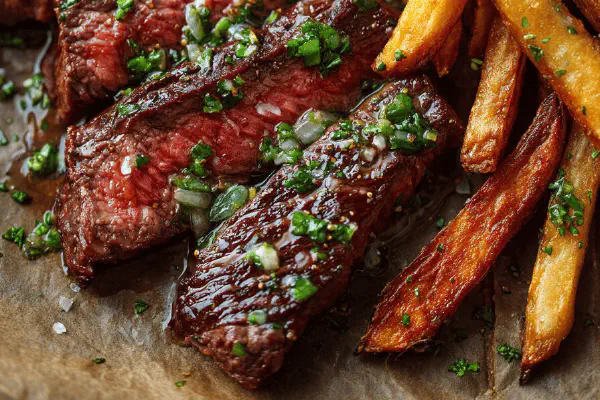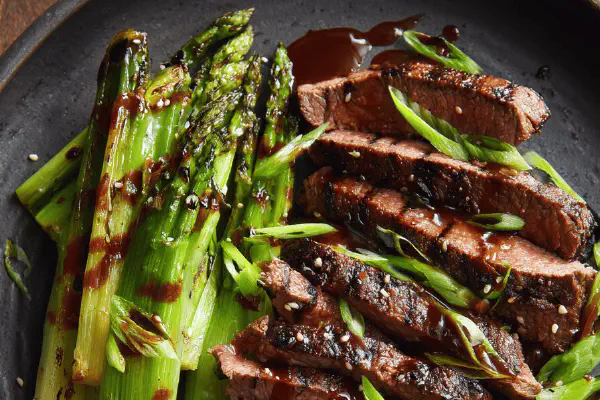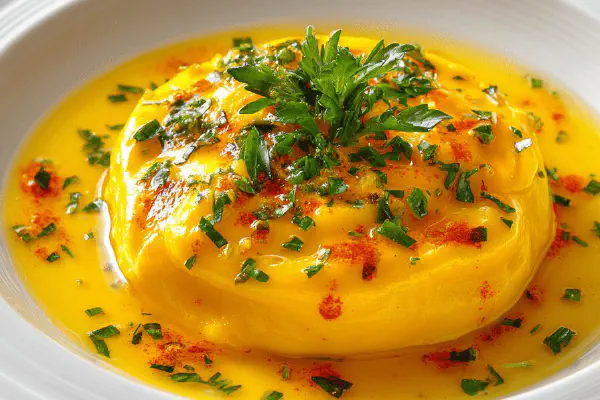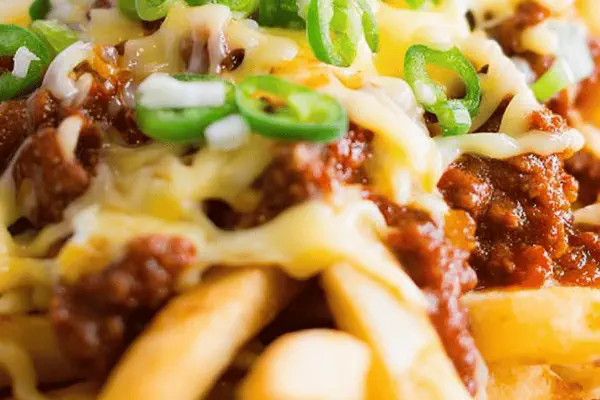Bavette Shallot Sauce Fries

By Emma
Certified Culinary Professional
Ingredients
Beef
- 200 ml red wine (about ¾ cup)
- 25 ml grapeseed oil (1 ½ tbsp)
- 3 sprigs fresh thyme stripped
- 2 garlic cloves minced
- 600 g flank steak cut into 4 steaks
- 25 g unsalted butter
Shallot Sauce
- 70 g thinly sliced shallots
- 140 ml dry white wine
- 15 ml sherry vinegar
- 45 g cold unsalted butter cut in cubes
Homemade Fries
- Russet potatoes peeled or scrubbed, cut into sticks
- Oil for frying (grapeseed or canola)
- Coarse sea salt
About the ingredients
Method
Marinade and Meat Preparation
- Score one side of each steak with shallow crosshatch. Don’t cut too deep or steak will dry.
- In bowl mix oil, red wine, thyme leaves, and garlic. Season with salt and pepper.
- Add steaks, coat well. Cover and toss in fridge 1 ½ to 3 hours — less time for fresher meat, more for flavor depth.
- Remove steaks, drain and pat dry. Marinade moisture ruins sear.
- Heat pan on high til smoking. Add butter, swirl to melt.
- Sear steaks 3 minutes per side for rare, longer if needed. Listen for sharp sizzles; fat should brown but not burn.
- Remove steaks to plate, tent loosely with foil, let rest at least 5 minutes to redistribute juices.
Shallot Sauce
- Sweat shallots over low heat with white wine and sherry vinegar. Slow simmer, reduce by nearly half, about 4-6 minutes.
- No boiling. Small bubbles, sauce thickens; should coat back of spoon.
- Off heat, whisk in butter cubes slowly one by one. Keep sauce fluid and silky; too hot kills emulsion.
- Season lightly with salt and pepper. Keep warm but don’t reheat or sauce will separate.
Fries
- Soak cut potatoes in warm water 10 minutes to pull starch. Drain and dry thoroughly on clean cloth or paper towels; damp fries cause splatter.
- Heat oil to 175°C (350°F). Fry potatoes in small batches 5 minutes. Slightly soft but pale.
- Drain on rack or paper towels; cool briefly.
- Increase heat to 190°C (375°F). Fry fries again 2-3 minutes till golden and crisp.
- Drain, salt immediately with coarse salt while hot.
Serving
- Slice rested steaks against grain thickly. Plate with fries and spoon shallot sauce over meat.
- Add handful of fresh parsley or a sprig of thyme for color if you want. No need for fuss.
- Eat immediately—fries lose crispness quickly.
Cooking tips
Chef's notes
- 💡 Marinate bavette minimum 90 minutes in red wine, thyme, garlic. Score meat shallow crosshatch first. Helps marinade penetrate, no dry spots inside. Don’t go too deep or juices leak; contains flavor. Cooler fridge longer time for depth. Watch time, too long dries meat.
- 💡 Dry fries thoroughly after starch soak warm water. Wet fries cause oil spit and burns. Use clean towels or paper towels. Don’t crowd drying area or steam forms. Small batches frying prevents oil temp drop; temperature critical to crisp crust and soft interior.
- 💡 Searing pan hot till smoking, butter added quick swirl to melt then steak in. Butter browns fast; if waits too long it burns. Listen for sizzle, fat browning but no black bits. Meat crust forms better with hot melted butter. Rest meat loosely tented; stops steam escaping too fast, keeps juices inside.
- 💡 Shallot sauce slow simmer white wine vinegar. Avoid big bubbles or boiling; small bubbles thicken sauce without bitterness. Whisk in cold butter cubes one by one off heat. Control temp or sauce breaks. If too hot sauce separates fast. Gentle emulsion creates that silky texture.
- 💡 Use grapeseed oil over olive oil for frying; neutral flavor, higher smoke point. Olive oil smokes earlier, aroma masks steak flavor. Russet potatoes only; waxy types go gummy. No skins crisp better but peel optional for rustic look. Salt fries hot, right after second fry; cold fries don’t hold salt.
Common questions
Why score bavette before marinating?
Helps marinade get deeper inside. Crosshatch shallow; don’t pierce too far or lose juices. Fixes bland center problems from my past fails. Surface gets more flavor bites, texture changes slight too.
Can I use olive oil for frying?
You can but high smoke point oils better. Olive oil smokes early, distinct aroma masks beef. Grapeseed or canola better. If stuck use light olive oil carefully heat. Monitor temp closely to avoid burnt taste.
Fries soggy or limp after frying, what’s wrong?
Usually moisture still inside. Soak pulls starch but dry well or oil spits and fries don’t crisp. Small batches so oil temp stays high; double fry crucial. If fries cold before salting salt won’t stick either.
How to store leftovers?
Cool before fridge. Reheat shallow pan or oven to keep fries crisp—microwave makes them soft. Steak best rested room temp before cooling then wrapped tight. Sauce store separate tight container. Reheat gentle to avoid sauce break.



